
We are interested in the neuroendocrine basis of aggressive behavior: How
do various hormones act on the brain to change an individual's behavior and make
it more aggressive? We use an integrative, systems approach combining
neuroendocrinology, ecology, behavior and evolution to approach this
question. We also use a nontraditional model species, the tree lizard,
which has many advantages over traditional model species. A major
advantage of this species is the presence of alternative phenotypes discussed
below. However, this species also is easy to study in the field, gives
discrete aggressive behaviors that are easy to quantify, adapts well to
captivity and can be raised in captivity. This work is currently funded by
the National Institute of Mental Health.

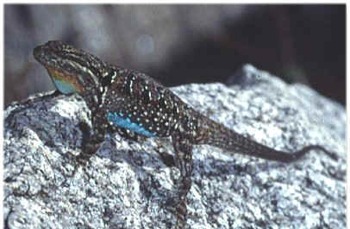 Our primary study organism, the common
tree lizard (Urosaurus ornatus). This male is giving the
aggressive Fullshow display which reveals his two primary color badges - the
multicolored dewlap or throat fan and the bright blue vental patches on the
abdomen. The color of this males dewlap reveals that he is of the
aggressive, territorial behavioral morph (see below).
Our primary study organism, the common
tree lizard (Urosaurus ornatus). This male is giving the
aggressive Fullshow display which reveals his two primary color badges - the
multicolored dewlap or throat fan and the bright blue vental patches on the
abdomen. The color of this males dewlap reveals that he is of the
aggressive, territorial behavioral morph (see below).
Photo by Blair Wolf.

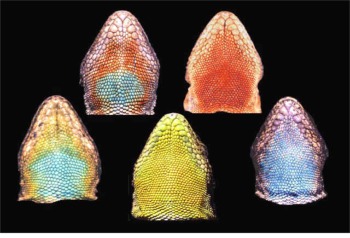 This
is a composite photograph of male tree lizard throats illustrating the variation in dewlap color in one population of
tree lizards. From left to right, the top row illustrates orange-blue and
orange males and the bottom row illustrates yellow-blue, yellow and blue
males. At least four other dewlap types have been documented in central
and southern Arizona that are not illustrated. Our main study population
has both orange and orange-blue males in about equal numbers with an occasional yellow, yellow-blue or blue male present. Other nearby populations have
completely different morph type frequencies.
This
is a composite photograph of male tree lizard throats illustrating the variation in dewlap color in one population of
tree lizards. From left to right, the top row illustrates orange-blue and
orange males and the bottom row illustrates yellow-blue, yellow and blue
males. At least four other dewlap types have been documented in central
and southern Arizona that are not illustrated. Our main study population
has both orange and orange-blue males in about equal numbers with an occasional yellow, yellow-blue or blue male present. Other nearby populations have
completely different morph type frequencies.

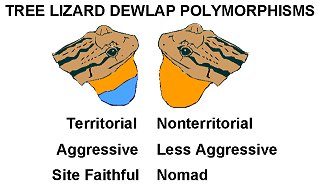 Our
current research is focused on the behavioral endocrinology of species with
alternative male phenotypes. Our study organism is the tree lizard which in our
main study population has two
types of males illustrated in the figure on the right. Males with orange-blue
dewlaps (throat fans) are aggressive and territorial whereas males with orange
dewlaps are less aggressive and do not defend territories.
Our
current research is focused on the behavioral endocrinology of species with
alternative male phenotypes. Our study organism is the tree lizard which in our
main study population has two
types of males illustrated in the figure on the right. Males with orange-blue
dewlaps (throat fans) are aggressive and territorial whereas males with orange
dewlaps are less aggressive and do not defend territories.

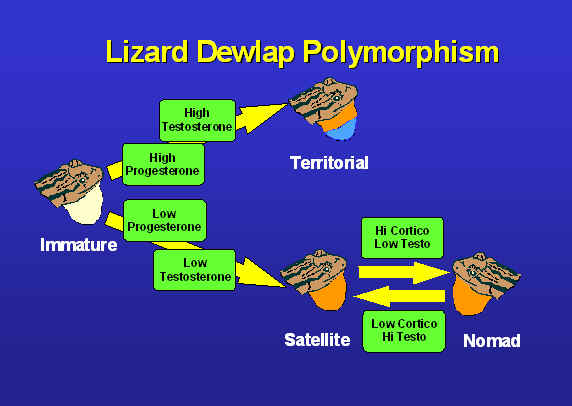 We are interested in
how hormones regulate differences between these different types of males. We
have discovered a role for hormones during early development in the
differentiation of the two male types. We have also recently discovered a role
for hormones during adulthood in switching the orange males between the two
reproductive tactics they practice. These results support the general conclusion
that differences within the sexes are controlled by hormonal mechanisms
similar to those that produce differences between the sexes.
We are interested in
how hormones regulate differences between these different types of males. We
have discovered a role for hormones during early development in the
differentiation of the two male types. We have also recently discovered a role
for hormones during adulthood in switching the orange males between the two
reproductive tactics they practice. These results support the general conclusion
that differences within the sexes are controlled by hormonal mechanisms
similar to those that produce differences between the sexes.

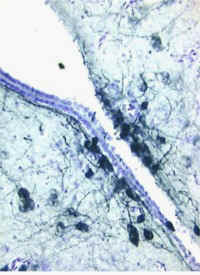 We have
recently expanded our interests in the endocrine basis of the difference in
aggressiveness between the two morphs of the tree lizard to an interest in the
neurobiological basis for this difference. We have been examining the
gross morphology of the brain nuclei in the two morphs and the distribution of
various neurochemicals and hormone receptors. This is a picture of the
distribution of arginine vasotocin immunopositive cells in the paraventricular
nucleus of the tree lizard hypothalamus. We think this is a key
neuropeptide in causing differences in aggressive behaviors between the morphs.
We have
recently expanded our interests in the endocrine basis of the difference in
aggressiveness between the two morphs of the tree lizard to an interest in the
neurobiological basis for this difference. We have been examining the
gross morphology of the brain nuclei in the two morphs and the distribution of
various neurochemicals and hormone receptors. This is a picture of the
distribution of arginine vasotocin immunopositive cells in the paraventricular
nucleus of the tree lizard hypothalamus. We think this is a key
neuropeptide in causing differences in aggressive behaviors between the morphs.

 Our
current research is focused on the behavioral endocrinology of species with
alternative male phenotypes. Our study organism is the tree lizard which in our
main study population has two
types of males illustrated in the figure on the right. Males with orange-blue
dewlaps (throat fans) are aggressive and territorial whereas males with orange
dewlaps are less aggressive and do not defend territories.
Our
current research is focused on the behavioral endocrinology of species with
alternative male phenotypes. Our study organism is the tree lizard which in our
main study population has two
types of males illustrated in the figure on the right. Males with orange-blue
dewlaps (throat fans) are aggressive and territorial whereas males with orange
dewlaps are less aggressive and do not defend territories.